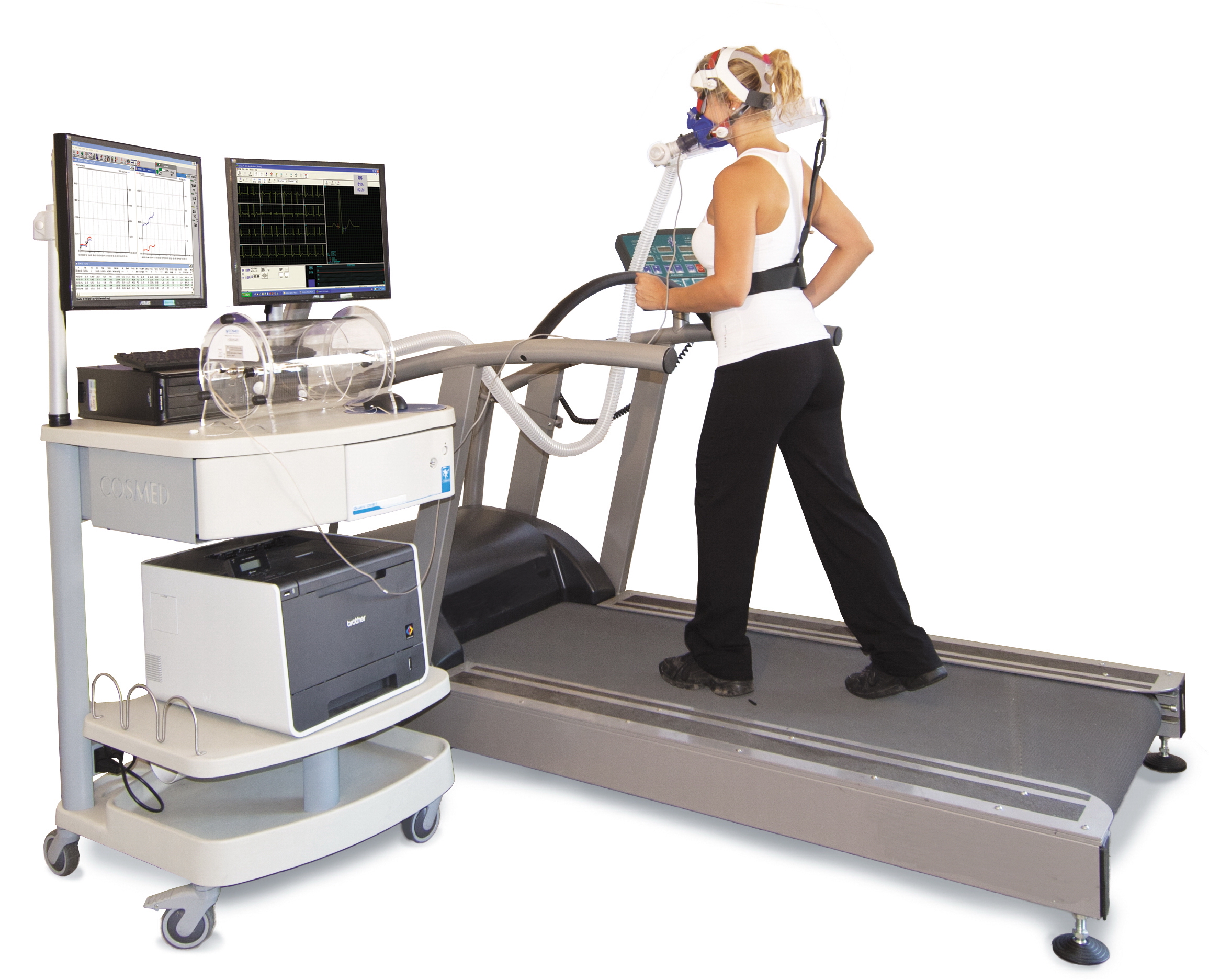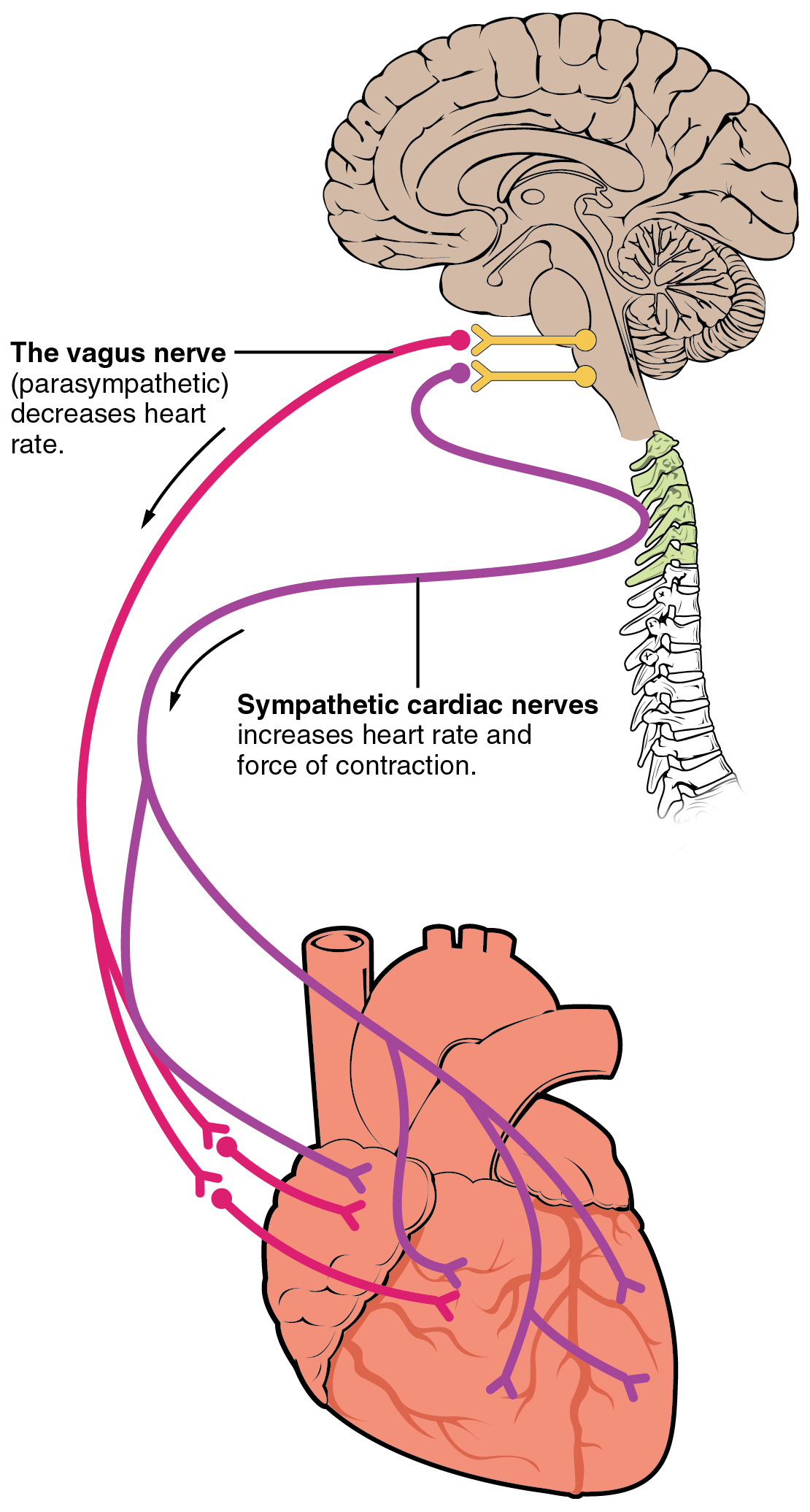|
Exercise Intensity
Exercise intensity refers to how much energy is expended when exercising. Perceived intensity varies with each person. It has been found that intensity has an effect on what fuel the body uses and what kind of adaptations the body makes after exercise. Intensity is the amount of physical power (expressed as a percentage of the maximal oxygen consumption) that the body uses when performing an activity. For example, exercise intensity defines how hard the body has to work to walk a mile in 20 minutes. Measures of Intensity Heart Rate is typically used as a measure of exercise intensity. Heart rate can be an indicator of the challenge to the cardiovascular system that the exercise represents. The most precise measure of intensity is oxygen consumption (VO2). VO2 represents the overall metabolic challenge that an exercise imposes. There is a direct linear relationship between intensity of aerobic exercise and VO2. Our maximum intensity is a reflection of our maximal oxygen consumpti ... [...More Info...] [...Related Items...] OR: [Wikipedia] [Google] [Baidu] |
Training Effect
Exercise physiology is the physiology of physical exercise. It is one of the allied health professions, and involves the study of the acute responses and chronic adaptations to exercise. Exercise physiologists are the highest qualified exercise professionals and utilise education, lifestyle intervention and specific forms of exercise to rehabilitate and manage acute and chronic injuries and conditions. Understanding the effect of exercise involves studying specific changes in muscular, cardiovascular, and Neurology, neurohumoral Biological system, systems that lead to changes in functional capacity and Physical strength, strength due to endurance training or strength training. The effect of training on the body has been defined as the reaction to the adaptive responses of the body arising from exercise or as "an elevation of metabolism produced by exercise". Exercise physiologists study the effect of exercise on pathology, and the mechanisms by which exercise can reduce or rever ... [...More Info...] [...Related Items...] OR: [Wikipedia] [Google] [Baidu] |
Human Power
Human power is work or energy that is produced from the human body. It can also refer to the power (rate of work per time) of a human. Power comes primarily from muscles, but body heat is also used to do work like warming shelters, food, or other humans. World records of power performance by humans are of interest to work planners and work-process engineers. The average level of human power that can be maintained over a certain duration of time is interesting to engineers designing work operations in industry. Human-powered transport includes bicycles, rowing, skiing and many other forms of mobility. Human-powered equipment is occasionally used to generate, and sometimes to store, electrical energy for use where no other source of power is available. These include the Gibson girl survival radio, wind-up or (clockwork) radio and pedal radio. Available power Normal human metabolism produces heat at a basal metabolic rate of around 80 watts. During a bicycle race, an elite cy ... [...More Info...] [...Related Items...] OR: [Wikipedia] [Google] [Baidu] |
Exercise Physiology
Exercise physiology is the physiology of physical exercise. It is one of the allied health professions, and involves the study of the acute responses and chronic adaptations to exercise. Exercise physiologists are the highest qualified exercise professionals and utilise education, lifestyle intervention and specific forms of exercise to rehabilitate and manage acute and chronic injuries and conditions. Understanding the effect of exercise involves studying specific changes in muscular, cardiovascular, and neurohumoral systems that lead to changes in functional capacity and strength due to endurance training or strength training. The effect of training on the body has been defined as the reaction to the adaptive responses of the body arising from exercise or as "an elevation of metabolism produced by exercise". Exercise physiologists study the effect of exercise on pathology, and the mechanisms by which exercise can reduce or reverse disease progression. History British phy ... [...More Info...] [...Related Items...] OR: [Wikipedia] [Google] [Baidu] |
Intermittent Fasting
Intermittent fasting is any of various meal timing schedules that cycle between voluntary fasting (or reduced calorie intake) and non-fasting over a given period. Methods of intermittent fasting include alternate-day fasting, periodic fasting, and daily time-restricted feeding. Intermittent fasting has been studied to find whether it can reduce the risk of diet-related diseases, such as metabolic syndrome. A 2019 review concluded that intermittent fasting may help with obesity, insulin resistance, dyslipidemia, hypertension, and inflammation. A 2022 review indicated that intermittent fasting is generally safe. Adverse effects of intermittent fasting have not been comprehensively studied, leading some academics to point out its risk as a dietary fad. The US National Institute on Aging states that there is insufficient evidence to recommend intermittent fasting, and encourages speaking to one's healthcare provider about the benefits and risks before making any significant changes ... [...More Info...] [...Related Items...] OR: [Wikipedia] [Google] [Baidu] |
Ketosis
Ketosis is a metabolic state characterized by elevated levels of ketone bodies in the blood or urine. Physiological ketosis is a normal response to low glucose availability, such as low-carbohydrate diets or fasting, that provides an additional energy source for the brain in the form of ketones. In physiological ketosis, ketones in the blood are elevated above baseline levels, but the body's acid–base homeostasis is maintained. This contrasts with ketoacidosis, an uncontrolled production of ketones that occurs in pathologic states and causes a metabolic acidosis, which is a medical emergency. Ketoacidosis is most commonly the result of complete insulin deficiency in type 1 diabetes or late-stage type 2 diabetes. Ketone levels can be measured in blood, urine or breath and are generally between 0.5 and 3.0 millimolar (mM) in physiological ketosis, while ketoacidosis may cause blood concentrations greater than 10 mM. Trace levels of ketones are always present in the blood and incr ... [...More Info...] [...Related Items...] OR: [Wikipedia] [Google] [Baidu] |
Hitting The Wall
In endurance sports such as road cycling and long-distance running, hitting the wall or the bonk is a condition of sudden fatigue and loss of energy which is caused by the depletion of glycogen stores in the liver and muscles. Milder instances can be remedied by brief rest and the ingestion of food or drinks containing carbohydrates. The condition can usually be avoided by ensuring that glycogen levels are high when the exercise begins, maintaining glucose levels during exercise by eating or drinking carbohydrate-rich substances, or by reducing exercise intensity. Etymology, usage, and synonyms The term ''bonk'' for fatigue is presumably derived from the original meaning "to hit", and dates back at least half a century. Its earliest citation in the ''Oxford English Dictionary'' is a 1952 article in the ''Daily Mail.'' The term is used colloquially as a noun ("hitting the bonk") and as a verb ("to bonk halfway through the race"). The condition is also known to long-distance (mar ... [...More Info...] [...Related Items...] OR: [Wikipedia] [Google] [Baidu] |
Heart Rate
Heart rate (or pulse rate) is the frequency of the heartbeat measured by the number of contractions (beats) of the heart per minute (bpm). The heart rate can vary according to the body's physical needs, including the need to absorb oxygen and excrete carbon dioxide, but is also modulated by numerous factors, including, but not limited to, genetics, physical fitness, stress or psychological status, diet, drugs, hormonal status, environment, and disease/illness as well as the interaction between and among these factors. It is usually equal or close to the pulse measured at any peripheral point. The American Heart Association states the normal resting adult human heart rate is 60–100 bpm. Tachycardia is a high heart rate, defined as above 100 bpm at rest. Bradycardia is a low heart rate, defined as below 60 bpm at rest. When a human sleeps, a heartbeat with rates around 40–50 bpm is common and is considered normal. When the heart is not beating in a regular pattern, this is ref ... [...More Info...] [...Related Items...] OR: [Wikipedia] [Google] [Baidu] |
Adenosine Triphosphate
Adenosine triphosphate (ATP) is an organic compound that provides energy to drive many processes in living cells, such as muscle contraction, nerve impulse propagation, condensate dissolution, and chemical synthesis. Found in all known forms of life, ATP is often referred to as the "molecular unit of currency" of intracellular energy transfer. When consumed in metabolic processes, it converts either to adenosine diphosphate (ADP) or to adenosine monophosphate (AMP). Other processes regenerate ATP. The human body recycles its own body weight equivalent in ATP each day. It is also a precursor to DNA and RNA, and is used as a coenzyme. From the perspective of biochemistry, ATP is classified as a nucleoside triphosphate, which indicates that it consists of three components: a nitrogenous base (adenine), the sugar ribose, and the Polyphosphate, triphosphate. Structure ATP consists of an adenine attached by the 9-nitrogen atom to the 1′ carbon atom of a sugar (ribose), which i ... [...More Info...] [...Related Items...] OR: [Wikipedia] [Google] [Baidu] |
Protein
Proteins are large biomolecules and macromolecules that comprise one or more long chains of amino acid residues. Proteins perform a vast array of functions within organisms, including catalysing metabolic reactions, DNA replication, responding to stimuli, providing structure to cells and organisms, and transporting molecules from one location to another. Proteins differ from one another primarily in their sequence of amino acids, which is dictated by the nucleotide sequence of their genes, and which usually results in protein folding into a specific 3D structure that determines its activity. A linear chain of amino acid residues is called a polypeptide. A protein contains at least one long polypeptide. Short polypeptides, containing less than 20–30 residues, are rarely considered to be proteins and are commonly called peptides. The individual amino acid residues are bonded together by peptide bonds and adjacent amino acid residues. The sequence of amino acid residue ... [...More Info...] [...Related Items...] OR: [Wikipedia] [Google] [Baidu] |
Heart Rate (exercise)
Heart rate (or pulse rate) is the frequency of the heartbeat measured by the number of contractions (beats) of the heart per minute (bpm). The heart rate can vary according to the body's physical needs, including the need to absorb oxygen and excrete carbon dioxide, but is also modulated by numerous factors, including, but not limited to, genetics, physical fitness, stress or psychological status, diet, drugs, hormonal status, environment, and disease/illness as well as the interaction between and among these factors. It is usually equal or close to the pulse measured at any peripheral point. The American Heart Association states the normal resting adult human heart rate is 60–100 bpm. Tachycardia is a high heart rate, defined as above 100 bpm at rest. Bradycardia is a low heart rate, defined as below 60 bpm at rest. When a human sleeps, a heartbeat with rates around 40–50 bpm is common and is considered normal. When the heart is not beating in a regular pattern, this is re ... [...More Info...] [...Related Items...] OR: [Wikipedia] [Google] [Baidu] |
Carbohydrates
In organic chemistry, a carbohydrate () is a biomolecule consisting of carbon (C), hydrogen (H) and oxygen (O) atoms, usually with a hydrogen–oxygen atom ratio of 2:1 (as in water) and thus with the empirical formula (where ''m'' may or may not be different from ''n''), which does not mean the H has covalent bonds with O (for example with , H has a covalent bond with C but not with O). However, not all carbohydrates conform to this precise stoichiometric definition (e.g., uronic acids, deoxy-sugars such as fucose), nor are all chemicals that do conform to this definition automatically classified as carbohydrates (e.g. formaldehyde and acetic acid). The term is most common in biochemistry, where it is a synonym of saccharide (), a group that includes sugars, starch, and cellulose. The saccharides are divided into four chemical groups: monosaccharides, disaccharides, oligosaccharides, and polysaccharides. Monosaccharides and disaccharides, the smallest (lower molecular weight) ... [...More Info...] [...Related Items...] OR: [Wikipedia] [Google] [Baidu] |





